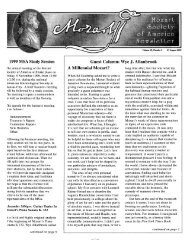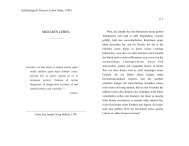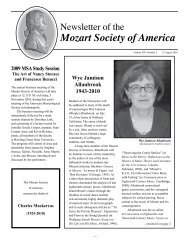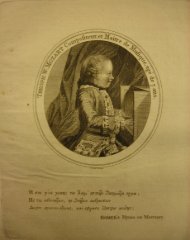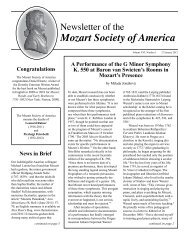January 2002 - Mozart Society of America
January 2002 - Mozart Society of America
January 2002 - Mozart Society of America
You also want an ePaper? Increase the reach of your titles
YUMPU automatically turns print PDFs into web optimized ePapers that Google loves.
Tomb <strong>of</strong> Countess Walsegg<br />
continuedfrom page 5<br />
attention has been paid to the second part<br />
<strong>of</strong> the Count's tribute to his late wife.<br />
Herzog, in a little known passage in his<br />
report, commented "if one may make a<br />
comparison <strong>of</strong> different kinds <strong>of</strong> art, one<br />
would think that a work <strong>of</strong> art in stone<br />
would last forever, and that one in paper<br />
would only be transitory, and yet at least<br />
in the case <strong>of</strong> the two monuments that<br />
Count von Walsegg had commissioned for<br />
his dear wife, the opposite is the case."<br />
The Count's choice <strong>of</strong> the double<br />
memorial appears to have been influenced<br />
by tributes to the great national military<br />
hero, General Field-Marshall Gideon<br />
Ernst Freiherr von Laudon, who died on<br />
14 July 1790. His standing at Court and<br />
his general popularity should not be<br />
underestimated. In 1788 Emperor Joseph<br />
II had embarked on a war against Turkey,<br />
and the course <strong>of</strong> hostilities was proving<br />
disastrous for the Austrians. Belgrade was<br />
occupied by the Turks, and the Viennese,<br />
remembering that Turkish armies had<br />
once laid siege to their own city, viewed<br />
these developments with concern. There<br />
was a large number <strong>of</strong> casualties in the<br />
field, food was running short, prices were<br />
rising, and enforced conscription into the<br />
Austrian army was proving extremely<br />
unpopular. The disastrous military<br />
campaign muddled on until ill health<br />
forced the Emperor to return to Vienna.<br />
At this point, von Laudon was appointed<br />
to lead the Austrians and in a short time<br />
he had made significant military gains.<br />
He recaptured Belgrade in October 1789,<br />
and when the news reached Vienna there<br />
was widespread jubilation as well as<br />
lavish military parades and religious<br />
ceremonies. Von Laudon was regarded as<br />
a great patriot, and prints were published<br />
praising him and his exploits.<br />
Dr. Anton Schmith, a talented amateur<br />
musician and a friend <strong>of</strong> <strong>Mozart</strong>'s,<br />
entered the following Latin verse, with<br />
some individual letters highlighted, in the<br />
composer's album on 31 October 1789:<br />
"PALLAS IN LOVDON IN MOZART<br />
REGNAT APOLLO,<br />
VIVET VTERQYE INGENS ARTE PER<br />
AEYASYN'<br />
[Pallas reigns in Laudon, Apollo in <strong>Mozart</strong>,<br />
Each shaUlive, great in his art throughout his<br />
life]<br />
With 1=1, V=5, L=50, D=500, and<br />
M=1000, this represents:<br />
0+50+1+50+5+500+1+1000+50+<br />
50+5+1+5+5+5+1+1+5+5=1789,<br />
the year <strong>of</strong> victory.<br />
A large section <strong>of</strong> a military museum<br />
in Vienna is devoted to Laudon's exploits<br />
with portraits, maps, books, and many <strong>of</strong><br />
the general's personal belongings,<br />
including his sword and medals, which<br />
remain part <strong>of</strong> the display. Laudon's<br />
remains were interred in a mausoleum<br />
that still stands in the Hadersdorf suburb<br />
<strong>of</strong> Vienna and the design <strong>of</strong> this tomb was<br />
similar to that used for Countess Walsegg.<br />
A Herr Joseph Muller (actually a<br />
Count Joseph Deym von Stritetz who had<br />
previously fled Vienna to avoid trouble<br />
with the authorities) opened a gallery in<br />
Vienna on 23 March 1791. (<strong>Mozart</strong>'s<br />
sister-in-law, Sophie Haibl, in her moving<br />
account <strong>of</strong> the events at the time <strong>of</strong><br />
<strong>Mozart</strong>'s death, identifies Muller as the<br />
party who made <strong>Mozart</strong>'s death mask.)<br />
The Wiener Zeitung announced on the<br />
26th that Muller had built in memory <strong>of</strong><br />
von Laudon a large model mausoleum<br />
and that it was illuminated from 8 in the<br />
morning to 10 at night. The notice ended,<br />
"Upon the stroke <strong>of</strong> each hour a Funeral<br />
Musique will be heard, and will be<br />
different each week. This week the<br />
composition is by Herr Kapellmeister<br />
<strong>Mozart</strong>."2 There seems little doubt that<br />
the tributes to Laudon influenced the<br />
thinking <strong>of</strong> Count Walsegg when he came<br />
to consider how to pay homage to the<br />
memory <strong>of</strong> his own wife.<br />
With the death <strong>of</strong> Count Walsegg and<br />
the reinterment <strong>of</strong> Countess Walsegg's<br />
remains in Schottwien parish church, the<br />
former tomb fell into further disrepair.<br />
With the passage <strong>of</strong> time, the stone<br />
remnants were taken for local building<br />
purposes and any obvious trace <strong>of</strong> it was<br />
eventually obliterated. It was mentioned<br />
in an essay by M. A. Becker in an 1877<br />
Austrian yearbook, but it was not until<br />
1991, the bicentennial year <strong>of</strong> <strong>Mozart</strong>'s<br />
death, that a search was begun in earnest<br />
to find the site <strong>of</strong> the former tomb.<br />
August Reisenbauer and friends from<br />
Gloggnitz, all with a keen interest in local<br />
history, banded together to form a search<br />
team.<br />
A late-nineteenth-century account<br />
giving details <strong>of</strong> buildings and<br />
monuments around Gloggnitz, hand<br />
written by a school director, Ferdinand<br />
-6-<br />
Hucklbacker, was unearthed. He had<br />
recorded a history <strong>of</strong> the tomb as<br />
remembered by one generation and<br />
passed down orally to the next. He wrote<br />
that it had been an impressive edifice<br />
with two reclining figures, one male and<br />
one female, carved on it. He related that,<br />
as a consequence <strong>of</strong> the war with<br />
France, helmets were placed on the<br />
heads <strong>of</strong> the two reclining figures with<br />
an inscription stating that "This<br />
monument is dedicated to the brave<br />
soldiers," although no date was given<br />
for this. The unauthorized changes<br />
caused some outrage at the time, and the<br />
two heads were cut <strong>of</strong>f by someone<br />
unknown and left lying in the grass.<br />
Hucklbacker noted that the<br />
monument fell into a ruinous state until<br />
scarcely any trace <strong>of</strong> either it or the<br />
Stuppach Park remained, but he did note<br />
some clues as to the general area where<br />
it had stood.<br />
Many <strong>of</strong> the estate papers <strong>of</strong> the<br />
Walsegg family had long since been<br />
dispersed, but an invoice mentioned<br />
repairs to gardens and bird cages close<br />
to the castle at Stuppach. This gave rise<br />
to the belief that the tomb had been<br />
situated some distance away from the<br />
castle itself. It was also reported to have<br />
been situated between Gloggnitz railway<br />
station and a bridge still standing in<br />
1875. To complicate matters, the<br />
Schwarza river had changed course<br />
since 1791, but available clues allowed<br />
the search to be narrowed to a wooded<br />
area about half a mile away from<br />
Schloss Stuppach.<br />
After a few months <strong>of</strong> prodding and<br />
digging, some stone remnants were<br />
discovered and an excavation<br />
commenced at what appeared to be the<br />
likely site. Confirmation soon followed.<br />
A carved slab in sandstone was<br />
unearthed and, as the search continued,<br />
more small items in stone, ceramic, and<br />
metal were also unearthed, as were a<br />
few coins dating back to the year 1800.<br />
Overall however, there was little to<br />
recover, and when the digging and<br />
marking <strong>of</strong> the site was complete, there<br />
was really nothing to suggest what had<br />
once occupied the location, simply a<br />
hole in the ground. The castle at<br />
Stuppach and the little chapel within it<br />
have been restored, but there are no<br />
plans at present to restore the memorial<br />
site.<br />
continued on page 14




